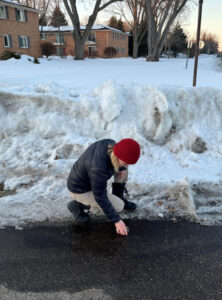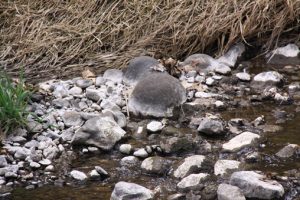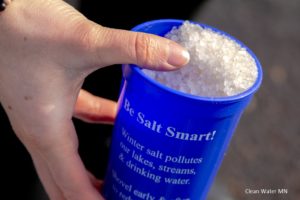Salt Watch Volunteer Program
Help test for chloride in the Nine Mile Creek watershed
Take part in our Salt Watch: Winter Curbside program!

Volunteer to collect chloride readings this winter from curbs and parking lots. These readings help the District locate chloride hotspots in the watershed. We can target outreach to these areas to hopefully help them reduce their salt use while still keeping people safe.
Volunteers in this program spend about an hour a month collecting samples from December to April (or whenever all the snow melts). All the data is uploaded to the Salt Watch program’s Clean Water Hub portal through the Izaak Walton League of America: cleanwaterhub.org/maps/salt-watch. The larger program measures chloride in lakes and creeks, but the District already monitors that (you can find that in our annual monitoring reports here: Lake and Creek Monitoring).
How do I participate?
If you’re interested in monitoring, order a test kit at the link below. Make sure you have identified a safe spot to collect runoff, like the street outside your house, a parking lot, or other out of traffic area. Double check that this spot is in our watershed boundaries by inputting the address here: Are You in the Watershed?
The kit includes three chloride test strips to measure the chloride in melt water coming off parking lots or running down curbs. Volunteers will sample during a melt period or after rain. Sampling once a month is best, whenever the water in the curb is flowing, not frozen. Your data gets uploaded to the Clean Water Hub and you are done! The kit comes with instructions to guide you through sampling and uploading data.
This program was created in partnership with the Izaak Walton League of America.
Why are we worried about chloride?

In 2004, the MN Pollution Control Agency (MPCA) placed Nine Mile Creek on the impaired waters list for chloride. This means that there is too much chloride (a component of de-icing salt) in the creek, and it is impacting plants, fish, and other aquatic life. Road salt is a major source of chloride pollution to Nine Mile Creek. The District promotes smart salting through its education program.
What is smart salting?
Smart salting aims to limit the amount of chloride people use while also keeping sidewalks, parking lots, and roads safe. When Smart Salting you should:
Shovel first—Shovel early and shovel often! Remove snow before it turns to ice. This way you need less salt and the salt will be more effective.
Scatter—Scatter matters. More salt does not mean faster melting. Aim for space between the granules. You only need about of coffee cup of salt for about 10 sidewalk squares or a 20 foot driveway.
Switch—Most salt stops working when the pavement is 15 degrees Fahrenheit. So salt should not be applied. Instead, switch to sand for traction.
Sweep—Sweep up salt and sand on dry pavement before it enters our waters. You can reuse the salt later instead of letting it wash down the storm drain.
Learn more here:
